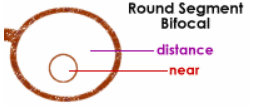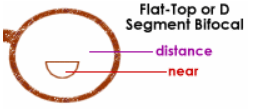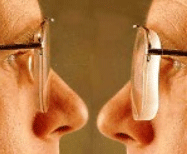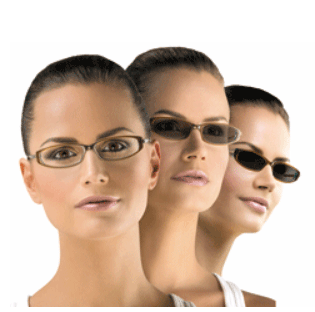 |
Types Of Lenses
 Single Vision Lenses: Single Vision Lenses:
Whatever we do - whether we are working, playing, reading or driving - we want to look great in our new eyeglasses. Essentially, we want perfect vision. These lenses are used to correct Myopia and Hypermetropia. They provide correction to the whole of the lens areas. A spherical lens has one dioptric power. A cylindrical or toric lens have a combination of two powers and this lens is used for correction of Astigmatism.
 Bi Focal Lenses: Bi Focal Lenses:
These type of lenses have two segments - one for distance and one for reading, combined in one lens. There is a visible line between the two segments. They come in 2 different designs to suit different uses and the customer's preference.
 Kryptok Bifocal: Kryptok Bifocal:
The inner segment is round in shape, and usually 28mm in size

 Flattop or 'D' Bifocal: Flattop or 'D' Bifocal:
The segment is in English letter 'D' and the
size of the segment is usually 28mm. The position of the segment
is de-centered for right eye and towards the nasal for left
eye.

 Hi-Index Lenses: Hi-Index Lenses:
Normal lenses of high power are very thick
with full aperture and when fitted on the spectacle the wearer
finds it heavy and bulky. To overcome this problem, hi-index
lenses were introduced. These lenses are up to 40% thinner and
lighter than standard lenses.

The density / refractive index
of Hi-Index lenses is more which makes the lens 20% to 50% thinner
than normal lenses. Thus, allowing the wearer to choose any
frame from the wide range available.
Advantages of Hi-Index
compared to normal lenses:
- They are 20% to 50% thinner and
the wearer can be sure of having lenses that don't put weight
on his/her nose
- More discrete lenses offering a more aesthetic
setting for the eye and yet allows for a wide range of frames.
The wearer's eyes are no longer concealed behind thick lenses.
- Ideally suited for AR (Anti-Reflection) coating to further
eliminate short images and improve transmission.
| |
Organic |
Mineral |
| Normal |
1.498 |
1.523 |
| Hi Index |
1.56 |
1.6 |
| |
1.601 |
1.7 |
| |
1.67 |
1.8 |
| |
1.74 |
1.9 |
 Progressives: Progressives:
When people reach the age of 40, they start
to have difficulty focusing objects at close range. Single vision
lenses can no longer be used for the entire range of vision
from near to far. As well as, traditional bifocal lenses provide
clear vision of objects in the distance and near ranges. Thus,
everything in between remains blurred. And, the visible dividing
line is a sign showing everyone that you are wearing bifocals.
Progressive lenses have different prescription segments blended
onto the lens, but without a visible line. There is a gradual
change from the distance vision at the top of the lens to the
near vision at the bottom.
Many people find that the Progressive
give them more natural vision from near to middle to distance,
and are more relaxing to wear, as the progression imitates natural
focusing and they can see better. In all Progressives, there
are three main are: Distance, Reading and Intermediate.
 OPTION A - Transitions
TM: OPTION A - Transitions
TM:
They are unique variable tint lenses that
offer all day comfort protection, versatility, value and style.
How do Transitions TM work?
- They contain sunlight-sensitive
photo-chromic molecules that cause the variable tint to lighten
and darken under different UV radiation and temperature conditions.
- They darken outdoors under high UV light and lighten indoors
under low UV light.
- They become darker at low temperatures
(cold climate) and lighter in hot conditions (warmer climate).
Why choose Transitions TM lens?
- Eye health protection: Transitions
TM lenses provide 100% protection from UV-A and UV-B radiation
even when inactivated. This helps reduce the chance of developing
cataracts.
- Visual comfort: The variable tint in Transitions
TM lenses adjusts to different conditions and helps absorb harsh
sunlight to reduce glare.
- Physical comfort: Made of plastic
that weight up to 50% less than glass, they sit more comfortably
on the nose.
- Durability: Besides being shock-resistant, they
have built-in scratch-resistance as well.
- Versatility: Because
the variable tint becomes clear indoors and darkens outdoors,
they can be worn at home, work, play… anytime. They are versatile
enough to provide all-day comfort and protection both indoors
and outdoors.
Transitions is a registered trademark of Transitions
Optical, Inc.
 OPTION B - Transitions
TM: OPTION B - Transitions
TM:
Transitions Lenses
are the #1-recommended Photochromic lenses in the world.

Transitions
Lenses change from clear to dark in the presence of ultraviolet
light, and block 100% of harmful UV rays. Our innovative photochromic
technologies have produced unparalleled lens performance in
nearly every lens design and material, including shatter-resistant
lenses, bifocals, trifocals, progressives, and standard and
high index materials.
When you choose Transitions Lenses, you
choose visual quality, visual comfort and convenient protection
with these performance features:
- Virtually as clear as regular
clear lenses indoors
- Even clearer with an anti-reflective
coating
- As dark as most sunglasses outside in bright light
- Fast to activate
- Fast to fade back
- Block 100% of harmful UV rays
- Reduce the effects of glare
- Reduce eye fatigue
- Improve contrast
- Offer the right tint at the right time in changing light.
 Who Can Wear Transitions®
Lenses? Who Can Wear Transitions®
Lenses?
Everyone who
needs protection from glare and UV rays can benefit from Transitions
Lenses. They are appropriate for children, adults and patients
with special eyecare needs. The tint level of Transitions Lenses
adjusts quickly as light conditions change to provide convenient
protection from glare and 100% blockage of harmful UV rays.

 Children & Transitions
Lenses Children & Transitions
Lenses
It's never too early to start
caring for your children's eyes. Children are excellent candidates
for Transitions Lenses. It is estimated that 80% of total lifetime
exposure to UV rays occurs before age 18. Children are more
susceptible to UV radiation because their eyes continue to develop
into the teen years. Children also require safe, shatter-resistant
lens materials. Transitions Lenses are the perfect solution
- available in sturdy, lightweight, shatter-proof materials.
Transitions Lenses provide the convenience of automatic protection
by blocking 100% of harmful UV rays. They also offer increased
comfort by reducing eye strain and fatigue. Transitions Lenses
help you instill a lifetime of Healthy Sight habits by promoting
good eye health in children.
 Patients with Special
Needs Patients with Special
Needs
Certain people develop a heightened sensitivity to light, known as photosensitivity,
and are more susceptible to visible light. Photosensitivity
can develop with conditions, such as diabetes or recent eye
surgery. The condition can also be caused by taking certain
prescription medications. Some medications, even those used
to treat conditions not related to vision, can cause the eyes
to be more susceptible to damage from UV rays. During product
testing, eyecare professionals were asked if Transitions Lenses
seemed a good choice for people with specific visual needs.
 Active Adults Active Adults
Protection from glare and UV rays is important
for the comfort and quality of your vision today. It's also
important for long-term care of your eyes. It's never too late
to help protect against the cumulative effects of UV rays, which
can lead to eye conditions that compromise the quality of your
vision.
 Photochromatic Lens:
They can change from clear state to dark tint when exposed to
sunlight. These lenses can be used throughout the year, indoors
or outdoors, in all climates and for various activities. Another
advantage of these lenses is that they are available in all
lens material and design. Popular colors are Grey and Brown. Photochromatic Lens:
They can change from clear state to dark tint when exposed to
sunlight. These lenses can be used throughout the year, indoors
or outdoors, in all climates and for various activities. Another
advantage of these lenses is that they are available in all
lens material and design. Popular colors are Grey and Brown.
 UV Lens: UV Lens:
UV-A is absorbed primary
by the lens of the eye, although a small percentage penetrates
the ocular media to reach the retina. UV-A is referred to as
the "near" UV ray. UV-B the "middle wave" ultraviolet radiation
is absorbed by the cornea and the lens but it can also reach
the retina. UV-C is absorbed by the zone in the stratosphere
and is called the "far" UV ray.
The intensity of UV rays exposure
depends on
- The season and the time of the day.
- The number
of cloudy and sunny days in the particular city.
- The altitude
at which the city is located. (It increases by 5% for every
1000 feet increase in altitude.)
- Outdoor enthusiasts like
sportsmen, athletes, architects, golfers, project engineers.
 Protection from UV
Rays: Protection from UV
Rays:
UV exposure can be reduced by more
than 75% by wearing
- Regular sunglass with UV cut-off lens.
- Transitions TM lenses.
- Any lens with anti-reflection coating.
They give complete protection from UV rays even if you have
normal vision. Doctors recommend these lenses whenever you are
outside to ensure 100% UV-B protection.
 Hard Coating: Hard Coating:
It is
a special coating done on plastic lenses and polycarbonate lenses
to make them scratch resistant which means that a normal CR-39
when used by any customer tends to get scratched due to its
softness and if they are hard coated then scratches caused due
to normal day to day usage by the customer is protected by this
coating.
The coating has a tendency of scratch resistance. It
will not make the lens scratch proof. Scratch resistance means
that the tendency of the lens surface to get scratched is reduced
and scratch proof is that the entire lens will not get scratched
at all.
 High Level Dip Coating: High Level Dip Coating:
In this process first the lens
is super cleaned by the ultrasonic, and then dipped in crystal
lacquer, maintained by super clean environment and at sub zero
temperature. The lens is then withdrawn from this lacquer by
robot PC controls and goes through 2 types of polymerization.
1st stage: 75C for 5 minutes.
2nd stage: 115C for 2 hours.
Advantages:
- The best hard coat available in the market.
- Highly durable
and virtually scratch proof.
- Best results of anti-reflection
coating achieved with this hard coating.
 AR (Anti-Reflection)
coating: AR (Anti-Reflection)
coating:
To improve both the vision through the lenses and the
appearance of the glasses, an anti-reflective coating (also
called AR coating) is applied. AR coatings are similar to the
coatings found on microscopes and camera lenses. They consist
of several layers of metal oxides applied to the front and back
lens surfaces. Because of the layering effect, AR coatings sometimes
have a hint of green or purple color, depending on the individual
manufacturer's formula.
Each layer is scientifically calculated
to block reflected light. The result is that you'll see a reduction
in glare, annoying reflections and halos around lights. This
is a great safety benefit when you're driving at night.
Also,
anti-reflective coating reduces both internal and external reflections
on the lenses themselves, creating a nicer cosmetic appearance.
Internal reflections appear as rings that make lenses look thick.
External reflections mask your eyes from a clear, complete view
when someone is looking at you. So with an anti-reflective coating,
eyeglass lenses appear thin or non-existent, and your eyes look
more natural.
Anyone on TV or whose photo is taken often benefits
tremendously from the coating, but really, all eyeglass wearers
would benefit from an anti-reflective coating from a cosmetic
point of view. If you have a strong prescription, you can use
the AR coating in conjunction with high-index lenses to make
your glasses look and feel as thin as possible.
With sunglass
lenses, an AR coating is better applied only to the back surface
of the lens (the surface nearest the eye). Because sunglass
lenses are so dark, the AR coating can wind up looking smeary
on the front surface. Coating the back side helps reduce the
reflections of light that enter from behind you and bounce off
the surface into your eyes. A back-side coated sun lens is much
more comfortable than an uncoated sunglass


|
|
|



